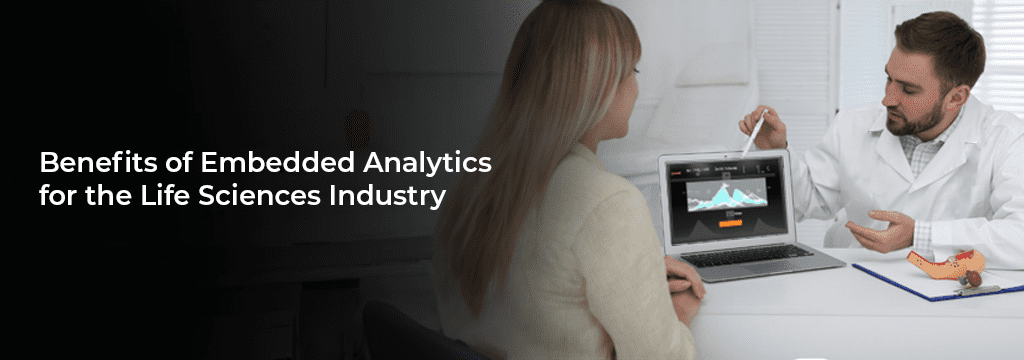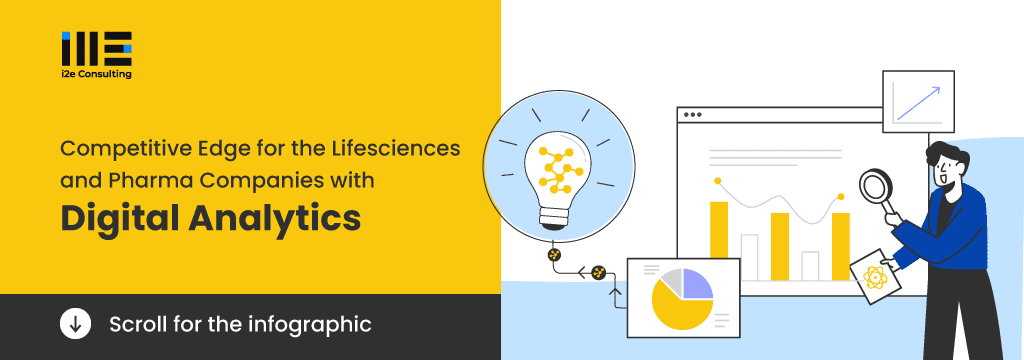
Benefit of Embedded Analytics is Transforming the Life Sciences Industry
Analytics always played a pivotal role in the life sciences industry. Owing to the dynamic and complex nature of drug development and marketing, pharma decision-makers rely heavily on data to decide on the future course of action.
According to a Worldwide Health Industry 2020 predictions report, the next decade will be defined by healthcare data and technologies needed to harness them (1)
As more and more data pours in, life sciences need to upgrade their analytics process to reduce manual interventions and adopt continuous real-time analytics. Embedded analytics can help them achieve this with less disruption to the existing systems and enabling the decision makers to spend less time making reports and more on taking decisions.
So, what is embedded analytics? And how can it help the life sciences companies? Read on as we give answers to these questions and give more insights on embedded analytics.
What is embedded analytics?
With embedded analytics, you can embed dashboards, reports, and analytic tools within your applications, solutions or websites. Which means, your team can generate dashboards and charts within the application where the data is stored, without the need to shuffle between two applications.
For example, if your organization is using Project Online or Planisware for project portfolio management, you can embed a powerful data visualization tool such as Power BI within Planisware to convert your insights into dashboards and graphs.
Switching between applications is a time-consuming and error-prone process that can lead to losing focus and in some cases valuable insights. Embedded analytics makes it easier and more efficient to pull insights and visualize them without moving back and forth.
Why Life Sciences Companies Should Consider Embedded analytics?
Embedded analytics in any existing software or applications can help various departments in the life sciences company to provide easy access to key metrics. Let us tell you some major benefits of embedded analytics in various departments.
- Increase the efficiency of clinical trials
Clinical trials play a major role in the drug development process, and embedded analytics can help you in making them quicker with reduced costs. Embedded analytics can help companies to constantly monitor key productivity metrics such as participant demographics, historical medical records, and past clinical events data.
Such information can help in optimizing the clinical trials process and in identifying test sites with high patient availability. Pharma companies can also speed up the trail by effectively analyzing the patient data from wearables and patient apps producing results in less time.
- Streamline production with market demand
Implementing embedded analytics into the production and inventory software applications can help companies gain insights into seasonal changes in demand, fast-moving drugs, and inventory metrics. Such insights can help production to dedicate more resources onto producing more drugs in demand.
Decision makers can now spend more time analyzing dashboards and graphs than creating them. With the time saved in going back and forth between applications, your decision-makers can effectively concentrate on decision-making.
- Improve decision making
Embedded analytics make collaboration within departments easy and convenient, thus helping your decision makers take holistic decisions. Your team leaders can engage better with scientists, drug research teams, government regulators and exchange ideas and information with ease.
The visual of the analytical dashboard make information exchange easier, the incoming data can be efficiently converted into dashboards. With embedded analytics, valuable data can be accessed making project outcomes more accurate, and easier to spot patterns in the data. Industry leaders can make decisions on portfolios, supply and demand, and company priorities.
- Increase customer satisfaction
Data-driven decision-making is the first rule for achieving customer satisfaction. However, data-driven decisions are made when the data is front and center, moving from one application to another to access dashboards and data can be tedious and time-consuming. Embedded analytics connects insights and plans of action in the same place, this helps companies to adapt better to the customer needs and incorporate data-backed decisions across the organization.
In the fast-moving pharmaceutical and biotech industries, staying ahead of competitors and making the right decisions faster are pivotal. Having an embedded analytical system means saving time moving back and forth between applications, continuous monitoring, saving time in report generation, and less dependency on the IT team.
Many of our clients have achieved increased productivity and saved report-generating time with embedded analytics. We have integrated Power BI into Planisware to help US Aramco get comprehensive dashboards within Planisware, you can read more details of it here.
References
- Federico Mayr, and Silvia Piai, “The Future of Intelligence in the Healthcare Sector, IDC
Here are five FAQs on the benefits of embedded analytics, suitable for inclusion in an article:
What are the primary benefits of embedded analytics in the life sciences industry?
Answer: In the life sciences industry, embedded analytics provides real-time data insights that improve decision-making, increases user adoption of analytical tools, enhances productivity by integrating data within existing workflows, offers better patient and research outcomes through tailored insights, and supports a data-driven culture across research and development teams.
How does embedded analytics improve decision-making in life sciences?
Answer: Embedded analytics allows life sciences professionals to access real-time data within their workflows, enabling faster and more informed decisions. Researchers, clinicians, and administrators can quickly interpret data trends, patient outcomes, and research results, leading to more timely and effective interventions and innovations.
In what ways does embedded analytics enhance productivity for life sciences professionals?
Answer: By integrating analytics directly into the applications life sciences professionals already use, embedded analytics streamlines workflows, reduces the time spent switching between different tools, and simplifies data access. This integration allows researchers and clinicians to focus on their core tasks while having continuous access to critical data and insights.
Can embedded analytics improve patient outcomes and research efficiency? If so, how?
Answer: Yes, embedded analytics can significantly improve patient outcomes and research efficiency. By providing real-time, actionable insights within existing clinical and research applications, professionals can make quicker, evidence-based decisions. This can lead to more effective treatments, faster research breakthroughs, and optimized resource allocation, ultimately benefiting patients and advancing scientific knowledge.
What cost advantages do life sciences organizations gain from using embedded analytics?
Answer: Life sciences organizations can achieve significant cost savings with embedded analytics by reducing the need for separate business intelligence tools and minimizing training expenses. Integrating analytics within existing systems helps lower licensing fees, reduces the time and effort spent on data extraction and report generation, and streamlines operations, leading to overall lower operational costs and more efficient use of resources.










